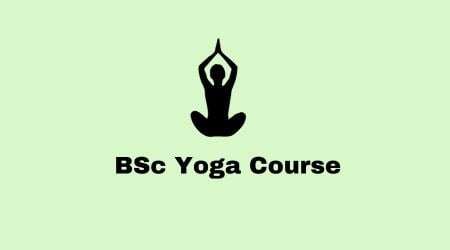BSc Yoga Course in India
BSc in Yoga is an undergraduate degree program that offers in-depth knowledge of yoga and its various aspects. This course is designed to provide students with a comprehensive understanding of the principles and practices of yoga, including its history, philosophy, and therapeutic applications. The course duration is typically three years, and it is offered by many universities and colleges in India.
The curriculum of BSc in Yoga consists of both theoretical and practical components. The theoretical component includes subjects such as Foundations of Yoga, Introduction to Hath Yoga and its texts, and Human Anatomy and Physiology. The practical component includes various yoga practices such as Asanas, Pranayama, Meditation, and Yoga Therapy. In addition to these core subjects, students may also have the opportunity to take elective courses in areas such as Yogic Dietetics and Physical Education.

After completing a BSc in Yoga, graduates can pursue a variety of career opportunities. They can work as yoga instructors, yoga therapists, research scholars, or trainers. They can find employment in health clubs, yoga studios, resorts, and private gyms. There is also a growing demand for yoga professionals in the healthcare industry, where they can work in hospitals, rehabilitation centers, and wellness clinics. Moreover, students can also opt for higher education in the field of yoga, such as MSc in Yoga, to enhance their knowledge and skills. Overall, BSc in Yoga offers a promising career path for those who are passionate about yoga and its benefits.
MSc Yoga
The course structure typically includes classroom teachings, seminars, assignments, and tutorials, providing students with a well-rounded understanding of the practice of yoga. The coursework is designed to develop strong foundational knowledge and practical skills, preparing students for a career in the field of yoga therapy. The duration of the course varies depending on the institution, ranging from 2-3 years.
Eligibility
To be eligible for admission to an MSc Yoga course in India, candidates must have a bachelor’s degree in any discipline from a recognized university with a minimum aggregate score of 50%. Some institutions may also require applicants to have prior experience in yoga practice or hold a relevant certification. The admission process typically involves filling out an application form, submitting academic transcripts, and appearing for an entrance exam. The complete course fee of the PG Yoga degree program ranges from INR 21,000 to INR 65,500
Colleges
Amity University
Guru Gobind Singh Indraprastha University
Sun Rise University Alwar
IIMT University Meerut
Morarji Desai National Institute of Yoga New Delhi
Baba Mastnath University Rohtak
Gautam Budha University Noida
Swami Vivekanand Yoga Anusandhan Samsthan Banglore
Periyar University
Nalanda University Diploma in Yoga
Distance Learning Colleges
Swami Vevekanand Yoga Anusandhan Samsthan Banglore
IGNOU Certificate programme in Yoga
The differences between BA Yoga and BSc Yoga
BA Yoga and BSc Yoga are two distinct undergraduate programs that differ in their approach to the study of yoga. BA Yoga focuses on the philosophical and cultural aspects of yoga, exploring its historical development and significance. This program emphasizes the study of yoga as a way of life, examining its ethical and spiritual dimensions. Students in this program may study Indian philosophy, Sanskrit, and other related subjects, and are often prepared for careers in teaching and research in the field of yoga.
In contrast, BSc Yoga is a program that emphasizes the scientific and practical aspects of yoga, including anatomy, physiology, and research methods. This program is designed to provide students with a deeper understanding of the physiological and psychological effects of yoga on the human body. Students in this program may study topics such as kinesiology, biomechanics, and exercise physiology, and are often prepared for careers in healthcare and wellness industries.
The career paths and opportunities for graduates of these two programs differ significantly. BA Yoga graduates may pursue careers in teaching and research, working in academic institutions, yoga studios, or other related organizations. BSc Yoga graduates, on the other hand, may pursue careers in healthcare and wellness industries, working as yoga therapists, fitness trainers, or in other related fields. While both programs offer valuable insights into the study of yoga, they differ in their focus and approach, providing students with a range of opportunities to explore their interests and passions in the field of yoga.
Course Structure of BA Yoga and BSc Yoga
| BA Yoga | BSc Yoga |
| Yoga Fundamentals | Yoga Foundation |
| Human Anatomy | Communicative English |
| Identification of Herbs | Human Anatomy and Physiology Practicum |
| Microbiology | Human Anatomy and Physiology |
| Medicinal Values of Herbs | Intro to Hath Yoga and its texts |
| Physiological Functions of the Human Body | Yoga Practicum |
| Bio-Chemistry | Environmental Studies |
| Demonstration of Surya Namashaaram and Preparation of one Yogic Diet | Essence of Principal Upanishads |
| Natural Yogic Diet | Human Anatomy & Physiology-II |
| Preventive Health Measures of Siddhar’s | Human Anatomy and Physiology Practicum-II |
| Siddhar’s Physiology | Patanjala Yoga Darshana |
| Simple Home Remedies | Yoga Practicum-II |
| Yoga in School Education | Computer Lab |
| Basics of “Thokkanam” & Varma (Basic of Oil Massage Techniques) | Basics of Samskritam |
| Model Yogic Lesson Plan for Teaching in Schools | Environmental Studies-II |
| Rule of Yoga in Health and Diseases | Essence of Bhagavad Gita for Personality Development |
| Stages of Yoga Practices | Methods of Teaching Yoga |
| Tirumoolar Tirumandiram and Patanjali Yoga Sutra | Yoga Practicum-III |
| Unit-I Demonstration of Yogasanas | Yoga and Holistic Health |
| Unit-II Simple Massage Techniques and Varma Point | Field Work |
What are the 4 major types of yoga?
Yoga manifests itself as four major paths, namely Karma Yoga, Bhakti Yoga, Rāja Yoga and Jñāna Yoga. These four paths are like the branches of a tree or tributaries of a river. They all have the same source and resting place
